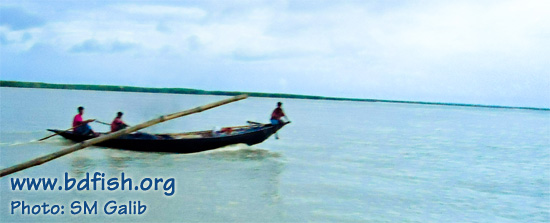
The Padma is the second longest river of Bangladesh (Hossain et al., 2005). It is the main distributary of the Ganges which originates in the Gangotri glacier of the Himalayan. The part of the Ganga in Bangladesh is known as the Padma which enters Bangladesh from India (Murshidabad district) at Shibganj Upazila (Manakosha and Durlavpur unions) of Chapai Nawabganj district. Its length in Bangladesh is 366 kilometers (Hossain et al., 2005). The Padma is joined by the mighty Jamuna (Lower Brahmaputra) and the resulting combination flows with the name Padma further east, to Chadpur. Here, the widest river in Bangladesh, the Meghna, joins the Padma, continuing as the Meghna almost in a straight line to the south, ending in the Bay of Bengal. Main stream goes through Chapai Nawabganj, Rajshahi, Pabna, Kushtia, Faridpur, Rajbari and Chandpur districts of Bangladesh. But according to Chowdhury (2003) the river from Goalanda to Chadpur is named Padma which is 120 kilometers long and 4-8 kilometers width; and the river flows from Chapai Nawabganj to Goalanda, is the Ganga.
Fish production
In the year of 2007-2008, a total of 9392 metric tons (MT) of fishes were harvested from the Padma which was 6.87% to the total fish captured from rivers of Bangladesh (FRSS, 2009). Catch composition was major carps (113 MT), other carps (18 MT), catfishes (969 MT), hilsa (3432 MT), large prawn (100 MT), small prawn (375 MT) and others (4385 MT) (FRSS, 2009).
Fisheries of the Padma
According to Islam and Hossain (1983), there were 110 species of fishes under 59 genera, 28 families, 12 orders and 2 classes. But recent studies have revealed that the diversity of fishes has decreased in this river as Bhuiyan et al. (2008) recorded only 73 species of fishes (under 44 genera, 22 families, 10 orders and 2 classes) and 11 non-fish species (under 4 classes). In another research, Samad et al. (2010) recorded 57 small indigenous species (SIS) of fishes under 23 families and 11 orders.
Jewel (2006) worked on fishing gears of the Padma river and 6 types of fishing nets, 4 types of traps and 1 wounding fishing gears were recorded by him. A total of 38 fish species were recorder to be captured with the recorded fishing gears.
In another research, 47 piscivorous vertebrates including 2 amphibian, 3 reptiles, 40 aves (birds) and 2 mammalian were recorded by Haque et al. (1983).
Physico-chemical properties
Ahmed (2004) recorded following water quality parameters in Padma river at Mawa Ghat of Munshiganj- pH (6.2-7.5), cloride (65.0-85.6 mg/l), alkalinity (57.7-110 mg/l), free carbon dioxide (2.3-13.4 mg/l), dissolved oxygen (5.1-10.3 mg/l), biological oxygen demand (BOD) (3.4-7.2 mg/l), total hardness (2.9-6.5 mg/l), permanent hardness (2.3-4.2 mg/l), total solids (175.5-472.1 mg/l) and dissolved solids (35.5-179.9 mg/l).
Different inorganic ions of the Padma water are- calcium (17.11-48.37 ppm), sodium (17.51-20.09 ppm), potassium (1.0-3.6), chromium (2.8-7.0) and sulphet (4.17-5.48 ppm); while the ions in bottom sediments were as follows- chromium (1050 ppm) and led (Pb) 12-48 ppm (Zereen et al., 1999).
Problems
At present time, flow of the Padma has reduced to a great extent. Continuous siltation in part few decades resulting in formation of almost permanent sand bars (island or chars). Abundance and diversity of fish and other aquatic species are gradually reducing. Use of illegal fishing nets (such as current jal) is a major problem which badly affects the overall fish production.
__________________________________________________________
REFERENCES
Ahmed A (2004) Ecological studies of the Padma river at Mawa Ghat, Munshiganj I. Physico-chemical properties, Pakistan Journal of Biological Sciences 7(11): 1865-1869.
Bhuiyan SS, Joadder MAR and Bhuiyan AS (2008) Occurrence of fishes and non-fin fishes of the river Padma near Rajshahi, Bangladesh, Univ. J. Zool. Rajshahi Univ. 27: 99-100.
Chowdhury MH (2003) Padma River. In: Banglapedia the National Encyclopedia of Bangladesh Vol. 5, Bangladesh Asiatic Society, Dhaka, Bangladesh. pp. 217-218 (in Bengali).
FRSS (Fisheries Resources Survey System) (2009) Fisheries Statistical Yearbook of Bangladesh 2007-2008, Department of Fisheries, Ministry of Fisheries and Livestock, Dhaka, Bangladesh, 25(1): 1-42.
Islam MS and Hossain MA (1983) An account of the fishes of the Padma near Rajshahi, Raj. Fish. Bull. 1(2): 1-31.
Haque MS, Hossain MA and Kasem MA (1983) A checklist of the piscivorous vertebrates of the river Padma of Rajshahi district, Raj. Fish. Bull. 1(2): 44-50.
Hossain ML, Mahmud J, Islam J, Khokon ZH and Islam S (eds.) (2005) Padma, Tatthyakosh Vol. 1 and 2, Dhaka, Bangladesh, p. 182 (in Bengali).
Jewel MAS (2006) Study on fishing gears and socio-economic conditions of fishermen of the Padma river, Abstracts 2nd fisheries conference and research fair 2006, Bangladesh Fisheries Research Forum (BFRF), Dhaka, Bangladesh, p. 61.
Samad MA, Asaduzzaman M, Galib SM, Kamal MM and Haque MR (2010) Availability and consumer preference of small indigenous species (SIS) of the river Padma at Rajshahi, Bangladesh, Int. J. BioRes. 1(5): 27-31.
Zereen F, Islam F, Habib MA, Begum DA and Zaman MS (1999) Inorganic pollutants in the Padma River, Bangladesh, Environmental Geology 39(9): 1059-1062.
Visited 8,399 times, 1 visits today | Have any fisheries relevant question?
